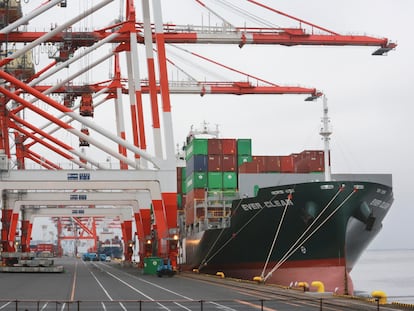Not-so-natural disasters and international trade
The smallest and most vulnerable economies suffer the greatest losses from environmental catastrophes, but policy changes can mitigate the impact
The number and frequency of natural disasters have markedly increased in recent decades, with climate change being one of the factors affecting this trend, especially in terms of hydro-meteorological disasters such as floods and droughts. The figure is close to 12,000 disasters in the period 1980-2018, and the economic cost of these disasters exceeds three trillion dollars, according to the International Disaster Database (EM-DAT).
By country, although the US ranks first in terms of frequency and economic damage caused, followed by China and India, the impact of disasters per capita or as a percentage of gross domestic product (GDP) indicates that the smallest and most vulnerable economies suffer the greatest losses. These account for up to 2% of GDP per year in Caribbean countries, while least developed countries (LDCs) are the most affected income group. When the frequency of such events increases, it acts as a brake on economic development, which is closely linked to external openness. An important question is how natural disasters – especially those induced by climate change – and international trade interact.
According to a recent study commissioned by the World Trade Organisation, such disasters interact with international trade in a very complex way. From a macroeconomic perspective, a natural disaster triggers resource destruction and a supply shock, leading to a reduction in output and employment. From the micro perspective, it affects all economic agents: companies have to face the destruction of their physical and human capital, workers face health problems and job losses, and finally, the state has to contribute to financing the losses suffered by both parties.
Trade enters into this puzzle on the supply as well as the demand side of the economy. Clearly, reduced production means that exports fall, not only due to the damage suffered by exporting firms, but also to the destruction of transportation infrastructure. In terms of demand, imports can temporarily act as a buffer, replacing domestic production and facilitating recovery. However, falling exports and rising imports would imply a deterioration of the trade balance. Moreover, if the economy that suffers the disaster is integrated into global value chains, indirect effects are generated for the members of these chains, the intensity of which depends on the position in the chain and the productive specialization of the affected country. For example, small and medium-sized enterprises in developing countries that specialize in intermediate inputs can create bottlenecks in value chains.
Both international trade and trade policy can be good ingredients for mitigating the effects of climate change-related natural disasters
Just as trade helps in the face of supply shortages in the country concerned, having a diversified supplier network is an advantage for all chain actors. An open trading system, therefore, favors resilience to natural disasters, and countries with integrated and competitive markets. Similarly, sectors that are not dependent on a single supplier are found to recover faster. As illustrated in the case of the European Union, not being highly dependent on the outside world is an advantage.
In terms of what trade policy actions can help the recovery of the affected country, the immediate response could involve offering special preferences to lower the cost of imports. Similarly, technical assistance could be offered to facilitate trade. For example, the EU temporarily eliminated tariffs on imports from Pakistan following the 2010 floods. Also, graduation from LDC status, which implies a withdrawal from the Generalized System of Preferences, has been postponed in several countries that have experienced natural disasters (the Maldives following the tsunami in 2004, Samoa in the aftermaths of a tsunami and a tropical cyclone). Finally, measures to build resilience should be based on enhanced international cooperation that goes beyond trade policy. In this regard, the Sendai Framework for Action 2015-2030 aims to reduce disaster risk and losses and promote an international disaster management plan to increase the resilience of value chains.
In short, both international trade and trade policy can be good ingredients for mitigating the effects of climate change-related natural disasters. While progress on initiatives at the international level is positive, there is a need for greater coherence and coordination between programs by building bridges between disaster risk management and multilateral trade policies.
Tu suscripción se está usando en otro dispositivo
¿Quieres añadir otro usuario a tu suscripción?
Si continúas leyendo en este dispositivo, no se podrá leer en el otro.
FlechaTu suscripción se está usando en otro dispositivo y solo puedes acceder a EL PAÍS desde un dispositivo a la vez.
Si quieres compartir tu cuenta, cambia tu suscripción a la modalidad Premium, así podrás añadir otro usuario. Cada uno accederá con su propia cuenta de email, lo que os permitirá personalizar vuestra experiencia en EL PAÍS.
¿Tienes una suscripción de empresa? Accede aquí para contratar más cuentas.
En el caso de no saber quién está usando tu cuenta, te recomendamos cambiar tu contraseña aquí.
Si decides continuar compartiendo tu cuenta, este mensaje se mostrará en tu dispositivo y en el de la otra persona que está usando tu cuenta de forma indefinida, afectando a tu experiencia de lectura. Puedes consultar aquí los términos y condiciones de la suscripción digital.
More information
Archived In
Últimas noticias
Most viewed
- Pablo Escobar’s hippos: A serious environmental problem, 40 years on
- Reinhard Genzel, Nobel laureate in physics: ‘One-minute videos will never give you the truth’
- Why we lost the habit of sleeping in two segments and how that changed our sense of time
- Charles Dubouloz, mountaineering star, retires at 36 with a farewell tour inspired by Walter Bonatti
- The Florida Keys tourist paradise is besieged by immigration agents: ‘We’ve never seen anything like this’










































